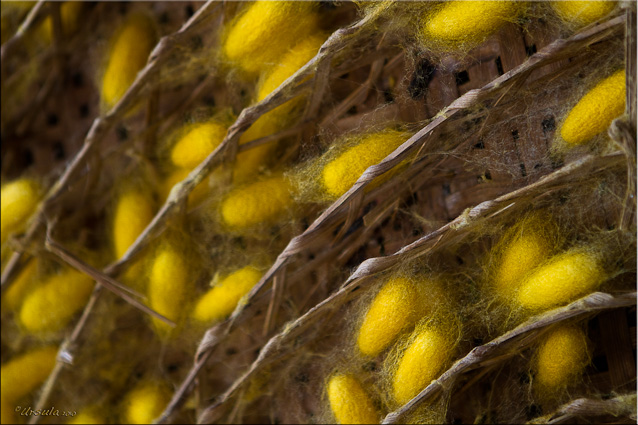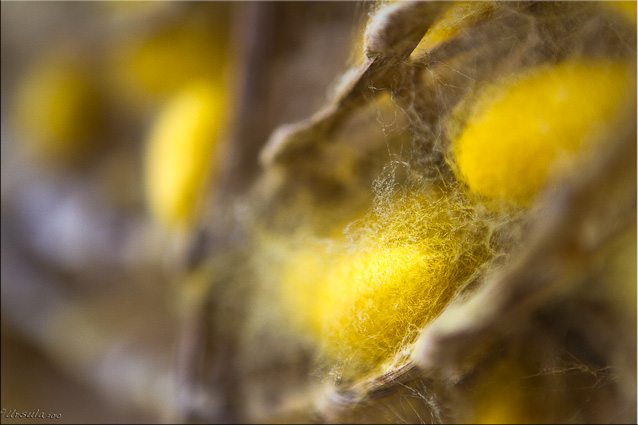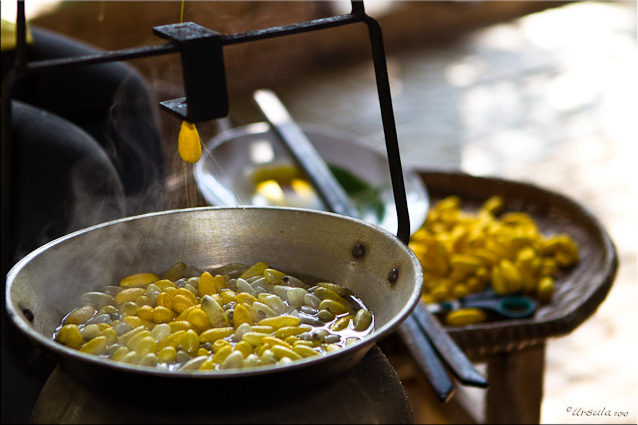
Silk Cocoons Nesting
The only downside, for me, of traveling to up-country Thailand, is that I end up with so many pictures I have trouble figuring out how to organise them!
I spent last weekend in Northeast Thailand (Isaan): Ubon Ratchathani, Sisaket and Surin. I was with a group of women from all parts of the world who were traveling, as members of The Thai Textile Society, in search of silks. Surin, in particular, has been producing beautifully hand-woven fine silk fabrics for over two thousand years. I was predominantly in search of images, although I confess that I also returned home with more than a few pieces of silk and cotton!
Silk production is a major cottage industry in this area, and is a source of community pride as well as income. Every stage of the production, from the growing and harvesting of the silk worms (sericulture), to the treating and dying of the threads, and finally the designing and weaving of the patterns, follows centuries-old traditions. For the sake of some sort of coherence, I decided to start at the beginning with the sericulture itself, and move on to the design, weaving and finished products next week.
Silk production is an incredibly labour intensive and costly job: about 3,000 cocoons and a lot of time are needed for just one meter of woven fabric.

Cocoons ~ like Cotton Candy

"Stoving" or "stifling" the chrysalis and "reeling" the threads
While this process is undeniably rough on the silk worms, there is, at least, no waste. Rejected shells are made into artificial flowers and other ornaments, the filaments become fabrics and the worms themselves become food.

"Chim Dai! ชิมได้!" "Have a taste!" Thanks, but no...

Explaining the Process of Reeling and Re-Reeling

Re-Reeling the silk fibres renders the filament a more even texture

Silk fibres ~ Rough-Raw and Smooth-Treated
After a lengthy treatment process, the silk filaments are ready for dying. Although commercial chemical dyes are sometimes used, most of the producers in Surin prefer the traditional, natural dyes from their own gardens.

Bixa Orellana: a source of red and orange dye

Tools of the Silk production trade

Isaan Workers in their Typical "Protective" Clothing, Keeping the Surrounds Tidy

Green Leaves and Yellow Silk

Dried Persimmon Peels make Red

Dye-Fires Burning

Boiling Dye Fires in the Yard

Terracotta Indigo Pots

Making the popular indigo-coloured silk is a laborious process of plunging and wringing...

... twisting and circling.

The skein of wet indigo silk needs to be kept in perpetual motion!

Threads on the Line ~ Dyed and Drying

Dyed, Spooled and Ready for weaving!
 As I said earlier, it is a long and involved process just to produce these fine silk filaments, which are not yet the beautifully coloured and textured fabrics they are destined to become!
As I said earlier, it is a long and involved process just to produce these fine silk filaments, which are not yet the beautifully coloured and textured fabrics they are destined to become!
Until next week, happy travels.























.png)


Hi Ursula,
Thanks for sending me the link of your website, I love it 🙂 and such interesting stories with wonderful images. Congratulations. Did you build the site yourself after your course?
Take care for now
Lesley X
Hi Lesley!
Thanks for stopping in – I’m glad you like it. The “design” is a bought theme (same as Jackie’s)… although my html skills are improving – slowly… 😉
Hello Aj. Ursula
Wow, I’m Thai but I never been to Isaan, that’s bad.
and you didn’t try the worms 🙂 (me neither)
Patama Ann
Thank you 🙂 I never seen before how they made the silk. 🙂
Great photos 🙂
Glad you like the photos, Virgonc! (Not as impressive as some of yours, I must say!!) Thanks for stopping by. 🙂
An amazing story beautifully told.
Thanks, Larry. Enjoy your time in Aus. 🙂
Hi Ursula,
thank you for sharing this interesting information and beautiful photos!
Hi Ulli! So glad you stopping in to have a look. 🙂
Hi,
Very nice pictures! We would like to go to Isaan/Surin too, to see the silk production. Is it possible to specify where in Surin this is because I don’t know whether it is hard to find a place where you can see all the steps of making silk.
Thanks
Hi Ines,
If you look at my Flickr site (http://www.flickr.com/photos/ursula_bkk/sets/72157625608000770/), you will find all my photos are geo-tagged so you see exactly where they are taken. These are from a number of places around Surin, but they are all on the map. Happy travelling!
Cool, a really interesting post!…
[..] Today I was reading this great blog post and I wanted to link to it. [..]…
hi. I’m a thai people and I come from Surin my proven also make silk. and my mom also make silk every step must talk a long time. but silk very wonderful. in my proven have many people make silk. here we have big land It can make farm I think if some one want to run besiness of silk I think very good.
but here me make for use in family. but I hope one day if have some one want to make besiness about silk and order from my proven every body here will got income from silk.
สวัสดี Yuwadee,
You are right – most families make silk for themselves. But, it is beautiful, and many people will buy it if they know where to find it! 😀